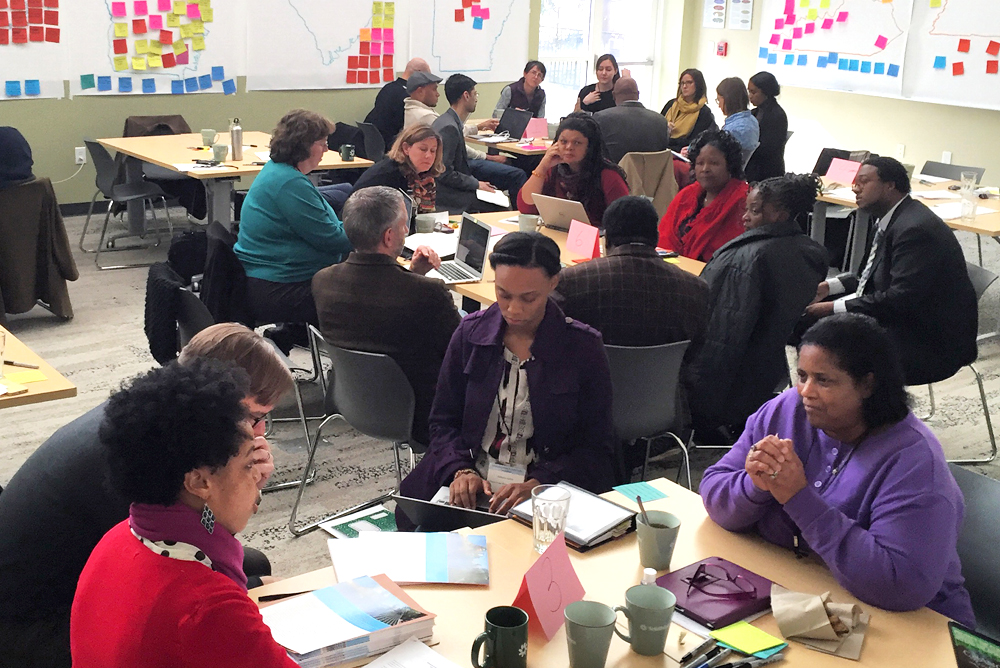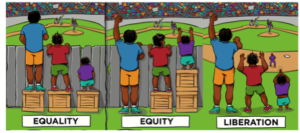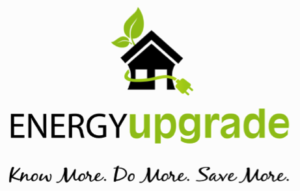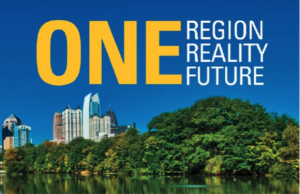CASE STUDY: Innovation in Equity and Energy Efficiency

Tackling Equity in the South Seems, at Times, Insurmountable.
Despite a long history of efforts to create a level playing field, southern communities still find the need to take action and this need goes beyond police precincts into urban sustainability programs. Today, the South’s local government sustainability practitioners are getting involved in conversations about inclusive access to energy efficiency programs and equitable distribution of energy rebates and efficiency upgrades. In 2015, Southeast Sustainability Directors Network (SSDN) members identified barriers to creating and delivering equitable energy efficiency programs in their communities such as programming with limited outreach to low-income communities and financial incentive programs that were only attractive to homeowners with good credit which leaves out a significant portion of the community. To begin addressing these barriers SSDN members participated in a project that used energy efficiency as a framework to more deeply understand how to incorporate equity goals into sustainability programs and initiatives.
Project Outcomes
Funded by an Urban Sustainability Directors Network (USDN) Innovation Fund grant, seven SSDN members embarked on a project to address equity in energy efficiency programming. While this project focused on energy efficiency programing, its reach stretched to establish foundational knowledge to help sustainability directors incorporate equity goals into the design and implementation of other sustainability programs as well.
Collaborating Communities:
- City of Knoxville, Tennessee (lead)
- City of Atlanta, Georgia
- City of Huntsville, Alabama
- City of Fayetteville, Arkansas
- Sarasota County, Florida
- City of Charlotte, North Carolina
- City of Memphis, Tennessee
Through this project SSDN members work collaboratively to integrate more equitable practices and approaches into their energy efficiency programs, while building their capacity to lead conversations about equity in their other sustainability programs, while developing consistent methodologies for framing and approaching equity in southern communities.
At the beginning of this project, SSDN collaborators expressed the following sentiments and goals for the project’s outcomes:
Engaging Regional Partners to Advance Knowledge and Skills: SSDN collaborated with the Partnership for Southern Equity (PSE) and Southeast Energy Efficiency Alliance (SEEA) to guide the project through training and developing an equity and energy efficiency toolkit. PSE and SEEA helped identify SSDN participants’ perceptions and depth of understanding of equity issues at the start of the project. The team then gathered participation data for each member community energy efficiency program to establish a benchmark for energy equity. The information gathered set a baseline for current understanding of equity and energy efficiency topics and refined city-level expectations for projects.
Intensive Training: In April 2016, SSDN collaborators participated in a two-day intensive training with PSE and SEEA in Atlanta. Participants discussed the history of inequity in the South related to land use, planning and policy development. They learned about how energy decisions are made and how partners are brought to the table. They learned and gained an understanding of the inequity faced by communities of color and low-income communities through the current energy system. For example well established data shows these communities are more likely to be exposed to air pollution from coal fired power plants, are most vulnerable to the effects of climate change and stand to benefit most from energy efficiency and employment programs that help lower bills. PSE taught SSDN members about elevating and connecting the voices of vulnerable populations to ensure equitable clean energy decisions for everyone, stressing to participants that these voices are the most under-represented in energy planning and decision making processes.
Equity in Energy Efficiency Toolkit: SSDN collaborators are currently working on the last deliverable of this project with SEEA and PSE. In this last activity they are developing an interactive online energy and equity toolkit for SSDN’s website. The online toolkit will launch in late 2016, and will function as the main source for SSDN members’ to find information about the ways local government and leadership can drive energy efficiency and equity changes in the south. The toolkit will help users understand equity in context and will focus on teaching practitioners how they can contribute toward the advancement of energy efficiency and equity in their work.
To understand context, the toolkit will provide a look back and the history of inequity in energy efficiency, provide a glossary of useful terms to help practitioners expand their lexicon, and provide samples of communication and data measuring strategies. To help advance equity in energy efficiency programs, the toolkit will provide in depth research about best practices, expertise and partners working in the field. It will also provide tips for working with partners to further projects, and provide resources about expertise available.
Project Outcomes
While work is still ongoing, SSDN member collaboration on this project has, so far, resulted in:
- Changes to current programming and outreach approach and structure
- Increased participation in energy efficiency programs by low-wealth populations
- Development of internal and external partnerships to advance equitable distribution of projects
- Collaborative ideas for future implementation projects on regional scale, e.g. TVA communities
“In previous efforts, the City was providing information and communications to low-income communities that were not effective. We hadn’t actually talked about disconnect with a specific “equity” lens or with recognition of the structural racial challenges. Now I feel equipped to openly have these conversations in order to improve the programs we deliver.”
“We are looking forward to progress locally and regionally, and becoming more fluent in this work.”
“We want to see collaborations start around working with utility partners and testing out specific ideas with them. We’re now ready to be more action-oriented.”
“We hope this project can help other SSDN sustainability directors understand the changing utility landscape, and encourage them to understand different models, while evaluating it with a true equity lens.”
— Collaborator comments about their learning experience
What’s next?
SSDN collaborators are already seeing impact from their efforts, and they’re seeing benefits from having an “equity lens” applied to their energy efficiency programs. Looking ahead they’re thinking about how this “lens” will advance efforts in other areas. Equity is something they’re striving to achieve in all of their sustainability programs. They are inspired by PSE and SEEA’s stories related to policy changes and working with elected officials, and they’re eager to take the next step to making more systematic change. SSDN members are already considering ideas for testing a pilot project or other efforts that could lead to collaborating with more southeast members to spread impact.
APPLYING THIS KNOWLEDGE IN YOUR COMMUNITY:
Important First Step: Establish a baseline of knowledge with your team about your local context. Explore these points of local context to begin your equity efforts.

Understanding Cultural Context + Critical Questions:
- Cultural Awareness: What is your awareness and understanding of the cultures of local vulnerable populations?
- Inequitable Systems: How well are existing systems working for vulnerable populations? Were there policies that created systems of inequity in your community like discriminatory bank lending through red lining or transportation planning to maintain segregation?
- Local History: What are the historical efforts from local government to reach vulnerable populations? Is there significant mistrust from government led efforts like urban revitalization in the 1970’s? What were the successes and the failures of local government?
- Current Engagement: How engaged are people from vulnerable populations in each stage of programs from planning and design to implementation to program participation?
- Measuring Success: What are the current practices for identifying, mapping, tracking or otherwise measuring program performance at a community scale? How can these evolve to track towards equitable outcomes?
SSDN MEMBER EXPERIENCE HIGHLIGHTSCity of Knoxville, Tennessee
Member leads: Erin Gill and Brian Blackmon
Local Energy Efficiency Project Application. The City of Knoxville sustainability staff, Erin Gill and Brian Blackmon, have been working on energy efficiency upgrade programs with utility partners for some time now. Yet they’ve struggled with effective and inclusive participation in these programs. The insights and perspectives gained through this project helped them make necessary changes to their engagement approach. This project taught them that asking for community input in the beginning can give you the needed insights to design campaigns and programs where the messaging and communications really resonates with the audience and boosts participation. What does this engagement look like? They started by connecting by holding focus groups and getting community members involved in designing the process and campaign. During the focus groups they asked community members how they learn best and what information would be useful to achieve the goals of the program. They also changed their delivery method: they started doing door-to-door campaigns using community members, and they asked them to train their neighbors to help with this messaging. This change in outreach technique informed their thinking so that their program design more effectively engages low income families in Knoxville.
Collaboration and Partnerships. Regional partnerships with the Tennessee Valley Authority (TVA) and Knoxville Utility Board (KUB) have been critical to the City of Knoxville strategy for some time now. However, now that Erin and Brian have gone through this SSDN equity program the conversation they’re now having is different and the methods for reaching low-wealth populations are improved. The City and the utility partners are also working with local grassroots community action organizations to meet the challenge of making the current energy business model more equitable. While TVA is sincere in their desire to innovate, it takes local guidance and pushing from folks like Erin and Brian to lead the effort and generate solutions, like the one shown in the example above.
Partnerships with SSDN member cities in the TVA distribution area like Nashville, Memphis, and Huntsville are crucial to progress on equity in energy efficiency programs. Through this project, Knoxville learned that collaboration with municipal peers is highly effective at motivating electric utilities and is important to influence regional action. The story is more compelling when multiple TVA communities are asserting that equity conversations are important to their constituents. In Erin’s opinion, “Having this conversation with TVA on our own would have been, and would continue to be, ineffective. We see city-to-city collaboration within the TVA region having the most potential to make a meaningful impact around equity.”
Walking the Talk. This project not only supported the Sustainability Office’s efforts with community programming and utility relationships but it also furthered their institutional goal to launch an equity initiative within city government. PSE and SEEA helped Erin and Brain understand a new lexicon related to energy and equity that they can now share and relate to their internal partners. After the training with PSE and SEEA, Brian developed a new working partnership with Knoxville’s GIS department to help him identify target audiences for participation in the energy upgrade program using block group U.S. Census data. This mapping data also helps him measure the number of people who signed up for the program more effectively.

Local Energy Efficiency Project Application
For several years Lee Hayes Byron and Sara Kane at the Sarasota County Sustainability Office have been working with their local utility partners to distribute residential energy and water efficiency kits. The kits, worth $35 each, have huge potential to make an impact in bills for both renters and homeowners. In previous years, their strategy for getting the message out entailed talking to and making presentations to any group that would invite them (e.g. church groups, the rotary, home owners associations). Sara and Lee Hayes found these groups were appreciative of having the information on water and energy efficiency and the kits, but could already afford the kits they were getting and weren’t able to maximize the use of the information they provided. When they joined the SSDN Equity and Energy Efficiency project they target this program for improvement.
Collaboration and Partnerships
The SSDN Equity and Energy Efficiency project and training allowed Sarasota County to change their approach to better reach low-wealth and minority audiences. Sara tailored her community presentation to be more appropriate for those with fewer resources, renters and those with other barriers to participation. She now highlights the resource-efficient steps and smaller steps they can take in the short term, for less cost. She also started reaching out to different stakeholders to find new opportunities to spread the message, like Habitat for Humanity and other nonprofits that work in low-income communities. For example, she recently presented to over 100 parents that are part of a low-income childcare network to get the information and kits into their hands. She’s also working with Salvation Army to identify more resources, so she can expand the reach of their workshops where she can teach homeowners how to use the kits.
Sara admits that this relationships building was challenging at first.
Sara says, “These were relationships that didn’t exist before, so it’s taken some time and patience to develop the partnerships that have allowed us to expand our message.” So far, however, her patience has paid off, and she has found success with these new partners.
Similar to Knoxville, Lee Hayes and Sara developed stronger relationships with the county’s GIS department. This new partnership within the walls of city hall identifies low-income neighborhoods to conduct educational workshops. GIS mapping also identifies the neighborhoods in which the new partners work, which allows them to better tailor messaging. They also use mapping to look at utility bill data, allowing them to understand where certain populations could improve energy usage. This series of data overlaid and applied to this program helps Sarasota County better target audiences that may want and need this public service.

Local Energy Efficiency Project Application
Like her peers Robin Cox, Huntsville Alabama Sustainability Consultant, has already been working with Huntsville Utility (HU), a distributor for the Tennessee Valley Authority (TVA) but used this program to guide that relationship in a more equitable direction. HU’s Communications & PR Director and Robin are working together to expand energy upgrades to a wider and specifically low-income audience. Robin feels like TVA/HU have made sincere and positive efforts in providing more equitable and inclusive energy efficiency programs upgrading around 1,200 houses in 18 months. She’s seeing impact in her own community, and it’s allowed for a new “equity” dialogue to emerge across TVA communities.
Robin sees energy efficiency programs as just the tip of the iceberg for where local government can encourage equity conversations. Now she’s focusing her efforts on influencing the way the energy and equity dialogue is continuously crafted across other areas of her work in Huntsville. For example, in response to recent violent racial tensions across the country, Huntsville started an effort that invites members of the police, fire, government groups, and other community groups to participate in a dialogue that addresses inequity in government and other areas. Robin is participating in this conversation, and she is finding that sharing good data and listening are the two of best strategies for public servants to harness in equity conversations.
She says, “I want to make impact by placing importance on having the right conversation first, and backing it up with data. Most of my work has been one-on-one at this point, and I’m starting to see people that look like me ask the right questions more than ever before.”
Using the Data
In Huntsville, Robin is using the training from Partnership for Southern Equity and the Southeast Energy Efficiency Alliance and data from PolicyLink to learn and guide her thinking on how to apply an equity lens to her work in the Green Team Office. PSE’s Metro Atlanta Equity Atlas (MAEA) has been very helpful as a tool for guiding her understanding about what data will be helpful in her work. She’s investigated the maps and data resources provided on the MAEA website, and is using the PolicyLink template to gather and harness similar data for the community. Robin is working with these community and neighborhood groups to outline a plan for gathering the appropriate updated data that Huntsville can use to make more equitable policy and planning decisions. Using MAEA and Policy Link as a resource, she is reaching out and establishing relationships that will allow her to gain access to the right data sets. In her opinion, developing a solid methodology for collecting updated, appropriate data that can inform work around energy and equity is something that SSDN members can continue to work on to get.